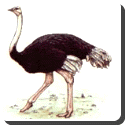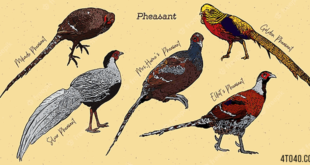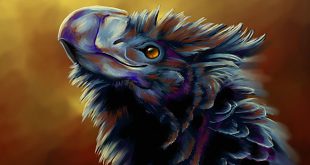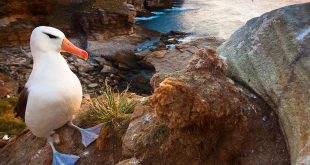 Ostrich — The Ostrich is one or two species of large flightless birds native to Africa, the only living member(s) of the genus Struthio. Some analyses indicate that the Somali Ostrich may be better considered a full species apart from the Common Ostrich, but most taxonomists consider it to be a subspecies.
Ostrich — The Ostrich is one or two species of large flightless birds native to Africa, the only living member(s) of the genus Struthio. Some analyses indicate that the Somali Ostrich may be better considered a full species apart from the Common Ostrich, but most taxonomists consider it to be a subspecies.
Ostriches share the order Struthioniformes with the kiwis, emus, and other ratites. It is distinctive in its appearance, with a long neck and legs and the ability to run at maximum speeds of about 70 kilometres per hour (43 mph), the top land speed of any bird. The Ostrich is the largest living species of bird and lays the largest egg of any living bird (extinct elephant birds of Madagascar and the giant moa of New Zealand did lay larger eggs).
The diet of Ostriches mainly consists of plant matter, though it also eats invertebrates. It lives in nomadic groups which contain between five and fifty birds. When threatened, the Ostrich will either hide itself by lying flat against the ground, or will run away. If cornered, it can attack with a kick from its powerful legs. Mating patterns differ by geographical region, but territorial males fight for a harem of two to seven females. These fights usually last just minutes, but they can easily cause death through slamming their heads into opponents.
The Ostrich is farmed around the world, particularly for its feathers, which are decorative and are also used as feather dusters. Its skin is used for leather products and its meat marketed commercially.
Ostriches usually weigh from 63 to 130 kilograms (140–290 lb), with exceptional male Ostriches weighing up to 156.8 kilograms (346 lb). The feathers of adult males are mostly black, with white primaries and a white tail. However, the tail of one subspecies is buff. Females and young males are greyish-brown and white. The head and neck of both male and female Ostriches is nearly bare, with a thin layer of down. The skin of the females neck and thighs is pinkish gray, while the male’s is blue-gray, gray or pink dependent on subspecies.
The long neck and legs keep their head 1.8 to 2.75 metres (6 to 9 ft) above the ground, and their eyes are said to be the largest of any land vertebrate – 50 millimetres (2.0 in) in diameter; they can therefore perceive predators at a great distance. The eyes are shaded from sun light falling from above.
At sexual maturity (two to four years), male Ostriches can be from 1.8 to 2.8 metres (5 ft 11 in to 9 ft 2 in) in height, while female Ostriches range from 1.7 to 2 metres (5 ft 7 in to 6 ft 7 in). During the first year of life, chicks grow about 25 centimetres (10 in) per month. At one year of age, Ostriches weigh around 45 kilograms (100 lb). Their lifespan is up to 40 or 45 years.
A female ostrich can determine her own eggs amongst others in a communal nest.
The Ostrich was originally described by Linnaeus in his 18th-century work, Systema Naturae under its current binomial name. Its scientific name is derived from Latin, struthio meaning “Ostrich” and camelus meaning “camel”, alluding to its dry habitat.
The Ostrich belongs to the ratite order Struthioniformes. Other members include rheas, emus, cassowaries, moa, kiwi and the largest bird ever, the now-extinct Elephant Bird (Aepyornis). However, the classification of the ratites as a single order has always been questioned, with the alternative classification restricting the Struthioniformes to the Ostrich lineage and elevating the other groups. Presently, molecular evidence is equivocal while paleobiogeographical and paleontological considerations are slightly in favor of the multi-order arrangement.
Ostriches formerly occupied Africa north and south of the Sahara, East Africa, Africa south of the rain forest belt, and much of Asia Minor. Today Ostriches prefer open land and are native to the savannas and Sahel of Africa, both north and south of the equatorial forest zone. In Southwest Africa they inhabit the semidesert or true desert. They rarely go above 100 metres (330 ft). The Arabian Ostriches in the Near and Middle East were hunted to extinction by the middle of the 20th century.
Ostriches normally spend the winter months in pairs or alone. Only 16 percent of Ostrich sightings were of more than two birds. During breeding season and sometimes during extreme rainless periods Ostriches live in nomadic groups of five to 50 birds (led by a top hen) that often travel together with other grazing animals, such as zebras or antelopes. Ostriches are diurnal, but may be active on moonlit nights. They are most active early and late in the day. The male ostrich territory is between 2 and 20 km2 (0.77 and 7.7 sq mi).
Ostriches become sexually mature when they are 2 to 4 years old; females mature about six months earlier than males. The species is iteroparous, with the mating season beginning in March or April and ending sometime before September. The mating process differs in different geographical regions. Territorial males typically hiss and use other sounds to claim victory over a harem of two to seven hens. The successful male will then be allowed to breed with all the females in an area, but will only form a pair bond with the dominant female.
It is claimed that Ostriches produce the strongest commercial leather. Ostrich meat tastes similar to lean beef and is low in fat and cholesterol, as well as high in calcium, protein and iron. Uncooked, it is dark red or cherry red, a little darker than beef.
 Kids Portal For Parents India Kids Network
Kids Portal For Parents India Kids Network





